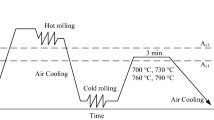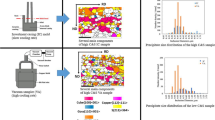Abstract
The decomposition and formation of ordered phases in steels with 5 to 6.5 %Si were investigated by a combined analysis of TEM and electrical resistivity measurements in order to determine the optimal heat treatment conditions for removal of ordered phases. TEM diffraction pattern study revealed that B2 ordered phase in 6.5 %Si steel was sufficiently dissolved by heat treatment at 850 °C for 1 h, and then rapidly re-formed during cooling. The critical cooling rate, above which the suppression of B2 phase formation was possible, increased rapidly with Si content higher than 5.6%. DO3 phase appeared only in the case of as-cast samples containing Si content as high as 6.5%. The measurement of electrical resistivity change during the heat treatment showed that the atomic movement was substantially spurred above 800 °C, resulting in an active order-disorder transition. The removal of solidification segregation is necessary to reduce the amount of B2 ordered phase in the as-cast or hot-rolled state, to lower the heat treatment temperature for dissolution of B2 ordered phase, and to shorten the heat treatment time.
Similar content being viewed by others
References
M. F. Littmann,IEEE Transactions on Magnetics 7, 48 (1971).
K. I. Arai and K. Ishiyama,J. Magn. Magn. Mater. 133, 233 (1994).
Y. Sato, T. Sato, and Y. Okazaki,Mater. Sci. Eng. 99, 73 (1988).
B. D. Cullity,Introduction to Magnetic Materials, p. 518, Addison-Wesley, Mass (1972).
B. Viala, J. Degauque, M. Barico, E. Ferrara, and F. Fiorillo,Mater. Sci. Eng. A 212, 62 (1996).
J. Bran≈zovsky, M. Jurisch, V. V. Maslov, W. Neumann, V. K. Nosenko, R. Sellger, and G. Richter,Mater. Sci. Eng. 98, 75 (1988).
P. R. Swann, L. Grånäs, and B. Lehtinen,Metal Science 9, 90 (1975).
K. Narita and M. Enokizono,IEEE Transactions on Magnetics 14, 258 (1978).
K. Narita and M. Enokizono,IEEE Transactions on Magnetics 15, 911 (1979).
J. H. Yu, J. S. Shin, J. S. Bae, Z. H. Lee, T. D. Lee, H. M. Lee and E. J. Lavernia,Mater. Sci. Eng. A 307, 29 (2001).
J. S. Shin, Z. H. Lee, T. D. Lee and E. J. Lavernia,Scripta materialia 45, 725 (2001).
D. R. Poirier and G. H. Geiger,Transport Phenomena in Materials Processing, p. 264, TMS, (1994).
H. Y. Kim, J. Matsuda, and K. Maruyama,Met. Mater.-Int. 9, 255 (2003).
W. Pfeiler,JOM 52, 14 (2000).
C. R. Barret, W. D. Nix, and A. S. Tetelman,The Principles of Engineering Materials, p. 383, Prentice-Hall, NJ (1973).
M. Abdellaoui, C. D. Mariadassou, and E. Gaffet,J. Alloys and Compounds 259, 241 (1997).
W. Kurz and D. J. Fisher,Fundamentals of Solidification, p. 289, Trans Tech Publications, Switzerland (1989).
E. Rabkin, B. Straumal, V. Semenov, W. Gust and B. Predel,Acta metall. mater. 43, 3075 (1995).
Author information
Authors and Affiliations
Corresponding author
Additional information
This article is based on a presentation made in the 2003 Korea-Japan symposium on the “Current Issues on Phase Transformations”, held at Marriott Hotel, Busan, Korea, November 21, 2003, which was organized by the Phase Transformation Committee of the Korean Institute of Metals and Materials.
Rights and permissions
About this article
Cite this article
Shin, J.S., Lee, S.M., Moon, B.M. et al. The effects of heat treatment condition and Si distribution on order-disorder transition in high Si steels. Met. Mater. Int. 10, 581–587 (2004). https://doi.org/10.1007/BF03027422
Issue Date:
DOI: https://doi.org/10.1007/BF03027422




